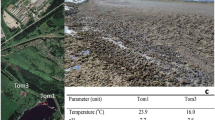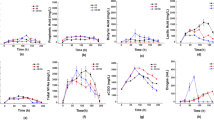Abstract
The microbiota of chicken litter remains largely unexplored, despite its leading role in the formation of volatile odorants and unpleasant odors. One of the main components of the odor is hydrogen sulfide, which may be formed as a result of microbial sulfate reduction. The composition of the microbial community of poultry plant waste was investigated. Samples were collected at the Mezheninovskaya large poultry farm, 15 km from the city of Tomsk, Russia. The 16S rRNA gene profiling revealed sulfate-reducing Desulfovibrionaceae in the microbial community. Both their share in the community and sulfide production increased upon incubation of the waste in the medium with sulfate and lactate. The possible sulfate sources in the waste are gypsum and the feed additives introduced as sulfates, such as lysine sulfate.



Similar content being viewed by others
REFERENCES
Bukhtiyarova, P.A., Antsiferov, D.V., Brasseur, G., Avakyan, M.R., Frank, Y.A., Ikkert, O.P., Pimenov, N.V., Tuovinen, O.H., and Karnachuk, O.V., Isolation, characterization, and genome insights into an anaerobic sulfidogenic Tissierella bacterium from Cu-bearing coins, Anaerobe, 2019, vol. 56, pp. 66‒77.
Dunlop, M.W., Blackall, P.J., and Stuetz, R.M., Odour emissions from poultry litter—a review litter properties, odour formation and odorant emissions from porous materials, J. Environ. Manage., 2016, vol. 177, pp. 306‒319.
Edgar, R.C., Search and clustering orders of magnitude faster than BLAST, Bioinformatics, 2010, vol. 26, pp. 2460–2461.
Fiedler, N., Kipen, H., Ohman-Strickland, P., Zhang, J., Weisel, C., Laumbach, R., Kelly-McNeil, K., Olejeme, K., and Lioy, P., Sensory and cognitive effects of acute exposure to hydrogen sulfide, Environ. Health. Perspect., 2008, vol. 116, pp. 78‒85.
Huang, C.B., Xiao, L., Xing, S.C., Chen, J.Y., Yang, Y.W., Zhou, Y., Chen, W., Liang, J.B., Mi, J.D., Wang, Y., Wu, Y.B., and Liao, X.D., The microbiota structure in the cecum of laying hens contributes to dissimilar H2S production, BMC Genomics, 2019, vol. 20, art. 770.
Ikkert, O.P., Gerasimchuk, A.L., Bukhtiyarova, P.A., Tuovinen, O.H., and Karnachuk, O.V., Characterization of precipitates formed by H2S-producing, Cu-resistant Firmicute isolates of Tissierella from human gut and Desulfosporosinus from mine waste, Antonie van Leeuwenhoek, 2013, vol. 103, pp. 1221–1234.
Karnachuk, O., Kurochkina, S., and Tuovinen, O., Growth of sulfate-reducing bacteria with solid-phase electron acceptors, Appl. Microbiol. Biotechnol., 2002, vol. 58, pp. 482–486.
Magoc, T. and Salzberg, S.L., FLASH: fast length adjustment of short reads to improve genome assemblies, Bioinformatics, 2011, vol. 27, pp. 2957–2963.
Rognes, T., Flouri, T., Nichols, B., Quince, C., and Mahé, F., VSEARCH: a versatile open source tool for metagenomics, PeerJ Preprints, 2016, vol. 4, e2409v1.
Trabue, S., Kerr, B., Bearson, B., and Ziemer, C., Swine odor analyzed by odor panels and chemical techniques, J. Environ. Qual., 2011, vol. 40, pp. 1510‒1520.
Trabue, S., Scoggin, K., Li, H., Burns, R., Xin, H., and Hatfield, J., Speciation of volatile organic compounds from poultry production, Atmos. Environ., 2010, vol. 44, pp. 3538‒3546.
Wadud, S., Michaelsen, A., Gallagher, E., Parcsi, G., Zemb, O., Stuetz, R., and Manefield, M., Bacterial and fungal community composition over time in chicken litter with high or low moisture content, Br. Poult. Sci., 2012, vol. 53, pp. 561‒569.
Funding
This work was in part supported by the Russian Foundation for Basic Research, project no. 19-14-00245, and the Ministry of Science and Higher Education of Russia.
Author information
Authors and Affiliations
Corresponding author
Ethics declarations
COMPLIANCE WITH ETHICAL STANDARDS
Conflict of interests. The authors declare that they have no conflict of interest.
Statement on the welfare of animals. This article does not contain any studies involving animals or human participants performed by any of the authors.
AUTHOR CONTRIBUTION
Sampling and microcosm experiments were carried out by E.A. Latygolets and M.A. Grigoriev. M. Kadyrbaev measured the hydrogen sulfide concentration. O.P. Ikkert performed diffraction and elemental analysis. Isolation of DNA from microcosms and the 16S rRNA gene sequencing were carried out by E.V. Gruzdev and A.V. Mardanov. Bioinformatic analysis of sequences was carried out by A.V. Beletsky. Data analysis and preparation of the article were performed by O.V. Karnachuk and N.V. Ravin. All authors participated in the discussion of the results.
Additional information
Translated by E. Babchenko
Rights and permissions
About this article
Cite this article
Gruzdev, E.V., Latygolets, E.A., Beletsky, A.V. et al. The Microbial Community of Poultry Farm Waste and Its Role in Hydrogen Sulfide Production. Microbiology 90, 507–511 (2021). https://doi.org/10.1134/S0026261721040044
Received:
Revised:
Accepted:
Published:
Issue Date:
DOI: https://doi.org/10.1134/S0026261721040044




